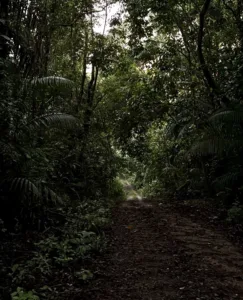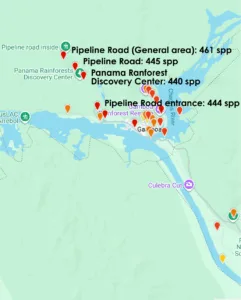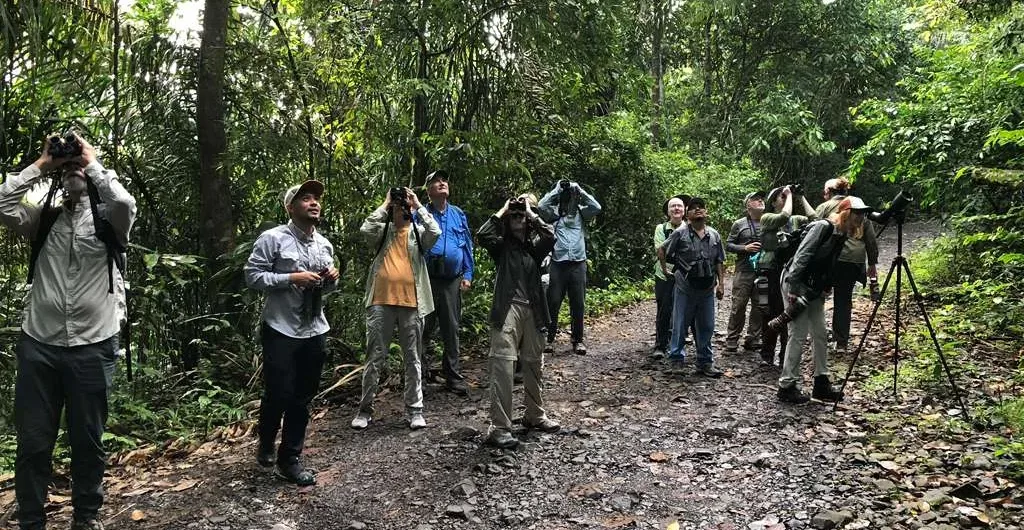
Imagine walking beneath shadowing rainforest trees, with the calls of trogons, antbirds, and tinamous echoing all around you. Sunlight filters through the canopy, and with every step, the promise of a new bird sighting takes you deeper into the forest. This is Pipeline Road, a legendary name in the birding world and one of the finest places to experience Neotropical biodiversity in the Americas. Pipeline Road was built during World War II as a service road for a petroleum pipeline constructed by the U.S. through the Canal Zone. The road was intended to allow the movement of oil across the isthmus should the canal be compromised, but the pipeline was never used. Over decades, the road has been overtaken by dense rainforest and is now largely used by scientists, birders, and eco-tourists.
Located within the Soberanía National Park, only about 50 minutes from Panama City and 10 minutes from Canopy Tower, Pipeline Road’s reputation was forever cemented in the 1970s. The exact history is not entirely clear, adding a bit of mystery to its legendary reputation among birders, but it was probably when the Audubon Christmas Bird Counts (CBCs), organized here by the Panama Audubon Society, in 1977 recorded 314 bird species in the Central Canal Area, the circle that includes Pipeline Road. Not bad for 24 hours! Even though other areas in the Neotropics and even in Panama recorded more bird species during similar periods, since the 1970s, Pipeline Road has become one of the favorite places for birding in the Neotropics.

Over the years, the list of birds has only grown, and nowadays, eBird shows from 444 to 461 documented bird species on Pipeline Road alone. Few places on the planet can rival such richness. Beyond its fame among birders, Pipeline Road has also been at the heart of science for decades, as it is visited by dozens of scientists every year to perform invaluable research and monitoring. In 1977, biannual bird censuses were established on this trail by the Smithsonian Tropical Research Institute (STRI). For 49 years now, STRI has carried out these bird censuses here, providing invaluable long-term data on the health of this tropical forest. Next year will mark the 50th anniversary of this unique census—half a century of continuous monitoring, right here along this trail. Scientists state that, like in other places around the world, bird populations on this unique trail are decreasing, which calls for efficient strategies to ensure the conservation of such unique biodiversity.
Birders come to Pipeline Road dreaming of unique encounters with mixed flocks and army ant swarms, which attract the charismatic Ocellated Antbird, Spotted Antbird, Bicolored Antbird, Gray-headed Tanager, Northern Barred-Woodcreeper, and, if you are extremely lucky, the amazing Rufous-vented Ground-Cuckoo. The elusive Streak-chested Antpitta, the dazzling Rufous Motmot, and the exceptional Great Jacamar calling above the treetops are also possible sightings, and Howler and White-faced Capuchin monkeys, Northern Tamanduas, Brown-throated Three-toed Sloths and innumerable insects, arachnids, reptiles and amphibians, fungae, and of course, fascinating plants may be encountered during your visit. Surprises are part of the journey, and every visit feels different.
Besides its outstanding biodiversity, this iconic trail is easily accessible, wide enough for a vehicle but used by few, easily walked as it is almost flat, and usually visited by only a few nature lovers. Muddy patches will be found, especially during the rainy season, but it’s all part of a birding trip-of-a-lifetime in the Tropics. At Canopy Family, we visit this trail from the Canopy Tower during either the morning or the afternoon, but our visitors can also enjoy a full-day trip with an amazing packed lunch. With the guidance of our expert naturalists—who know this road like an old friend- visiting this trail is an experience of a lifetime, and at Canopy Family, we know how to make it special!


